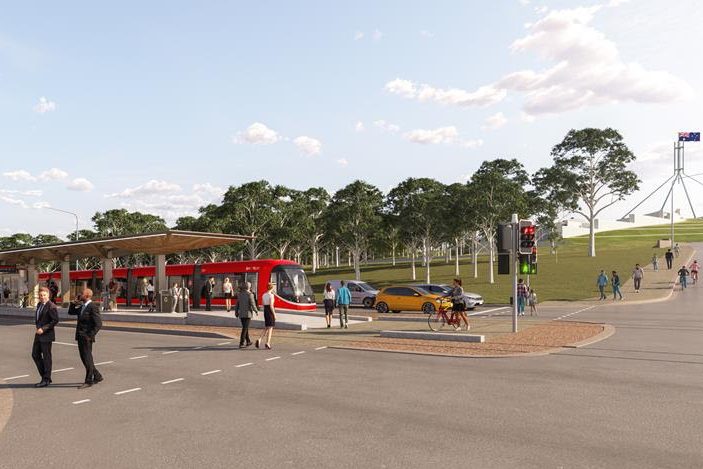
“As you grow up, Molonglo, aim to be the exception among the town centres of this city, a place that does not just destroy nature but gives back as much as it possibly can,” writes BEATRICE BODART-BAILEY
Congratulations, Molonglo, on becoming Canberra’s sixth town centre. The ritual of turning a serene, green landscape into a town centre of concrete, glistening glass and steel has already begun.

Heavy machinery has moved in shaving away the mantle of green vegetation and revealing an ever-increasing patch of dry soil, like clothing torn away revealing a naked body.
Yes, Molonglo, the custom of this land demands that the natural vegetation of this once beautiful valley be stripped and replaced by concrete, steel and glass with little vegetation in-between.
To mitigate the heat in those new concrete boxes, an army of air conditioners will blow out hot air into what was once a shady valley.
In other countries we find examples of people and nature living in harmony.
When the medieval university town of Heidelberg, Germany, was running out of space for its growing population in the 1960s, they opted for a new suburb sensitively placed into the forests overlooking the Rhine valley. Only the vegetation of plots where buildings were placed was removed, with a good distance kept between structures, so that every window and balcony is surrounded by trees.
The forest in today’s photos was there when, shortly after construction, my mother moved into one of the penthouses surrounded by treetops. Naturally, trees had to be felled to construct the trunk road for buses to Heidelberg’s centre, but the shortcut to the local shops as a well-maintained forest path.
Such nature-sensitive planning would make it difficult to produce the 70,000 homes the planning minister announced for Molonglo, perhaps hoping that by conjuring up a glut of homes for those desperately seeking accommodation, he would receive sufficient support at the next election after so many much-criticised mishaps.
Large homes for all – Australians occupy the largest living space per person in the world – is what the electorate wants, but the Greens cannot approve the felling of so many trees.
They insist that 70 per cent of new homes must be provided by infill in older suburbs. In other words, first the trees in the gardens of the inner suburbs must be sacrificed.
The CSIRO established that those suburbs with 30 per cent tree cover have temperatures 13 degrees lower in the heat of summer.
But we must be democratic. Let those in the older suburbs have their tree cover reduced to accommodate infill and swelter in the heat like people in the new suburbs.
When El Nino revisits with days of 40C, the lack of vegetation is likely to push temperatures to the 50s, injurious to health. Western Sydney has already experienced these temperatures and the physical harm to people as well as the enormous cost of labour lost has been well established.
In this seemingly unsolvable competition of space for homes and trees in our cities, the Italian architect Stefano Boeri came up with a solution: his Bosco Verticale, his Vertical Forest.
Two towers in Milan, 110 metres and 84 metres respectively, with a total of 27 storeys provide 40,000sqm space for people and for 20,000 trees and perennial plants, eliminating 20,000 kilograms of carbon annually.
Completed a decade ago, this vertical forest building demonstrates how plants can survive in this environment, nourished by recycled water and eliminating considerably more CO2 than the building produces. The plants also protect the apartments from noise-pollution and dust. Wind generators on the roof and photovoltaic systems along the façade reduce energy consumption.
Boeri’s design has been honoured with prizes and distinctions and inspired others to follow suit. From Bogota and Sāo Paulo to Singapore and Tokyo, vertical forest buildings have sprouted. Even a 19-storey social housing tower in the Dutch city of Eindhoven, Boeri clad with 8500 plants.
Here in Australia we have Sydney’s “One Central Park” with its 38,000 shrubs and 42,000 reflective mirrors to bring light to shaded areas. Brisbane is still working on getting the design of its vertical forest building approved.
And Canberra? Surely it’s time for our so progressive capital to invest in greening the city. Imagine if the new hotel facing Garema Place in Civic would be covered with thousands of plants: a drawcard for tourists and the local population alike, breathing life and oxygen into Canberra’s concrete soul.
For Molonglo finding the financial support for a vertical forest building might be problematic. But there are less costly solutions for the new town centre to turn itself into the greenest and coolest of the six.
The answer is green roofs, especially for all commercial buildings. In European cities, roofs have been turned into gardens and parks, at times even connected by bridges. Shady trees significantly reduce the summer heat and CO2, but even wicking beds on roofs, growing fresh vegetables, strawberries and raspberries, mitigate the heat and contribute to the well-being of people. As you grow up, Molonglo, please don’t strive to imitate the other five.
Rather, aim to be the exception among the town centres of this city, a place that does not just destroy nature but gives back as much as it possibly can.
Historian Beatrice Bodart-Bailey is an honorary professor at the ANU School of Culture, History and Language and an emeritus professor of the Department of Comparative Culture, Otsuma Women’s University, Tokyo.
Who can be trusted?
In a world of spin and confusion, there’s never been a more important time to support independent journalism in Canberra.
If you trust our work online and want to enforce the power of independent voices, I invite you to make a small contribution.
Every dollar of support is invested back into our journalism to help keep citynews.com.au strong and free.
Thank you,
Ian Meikle, editor





Leave a Reply